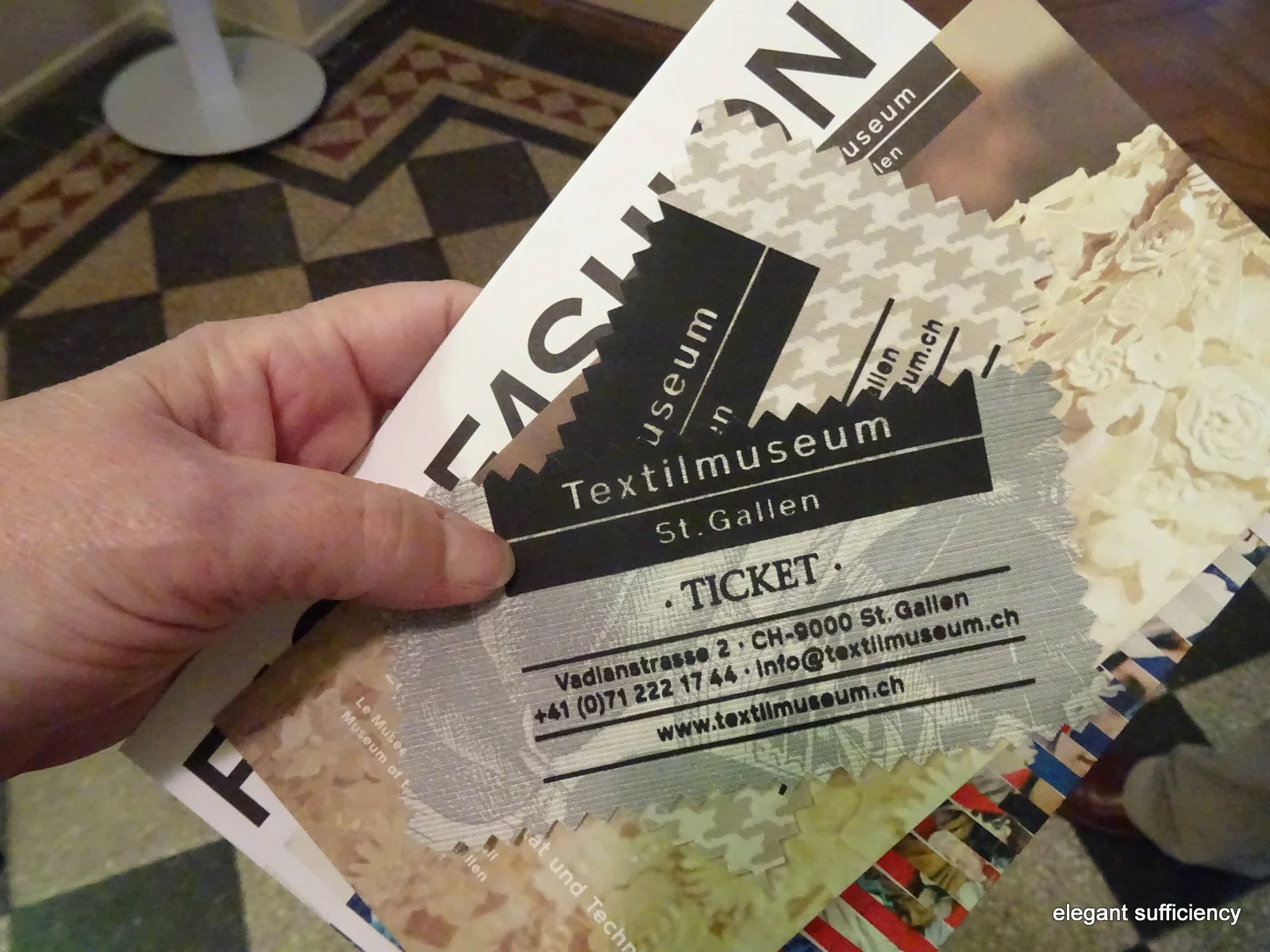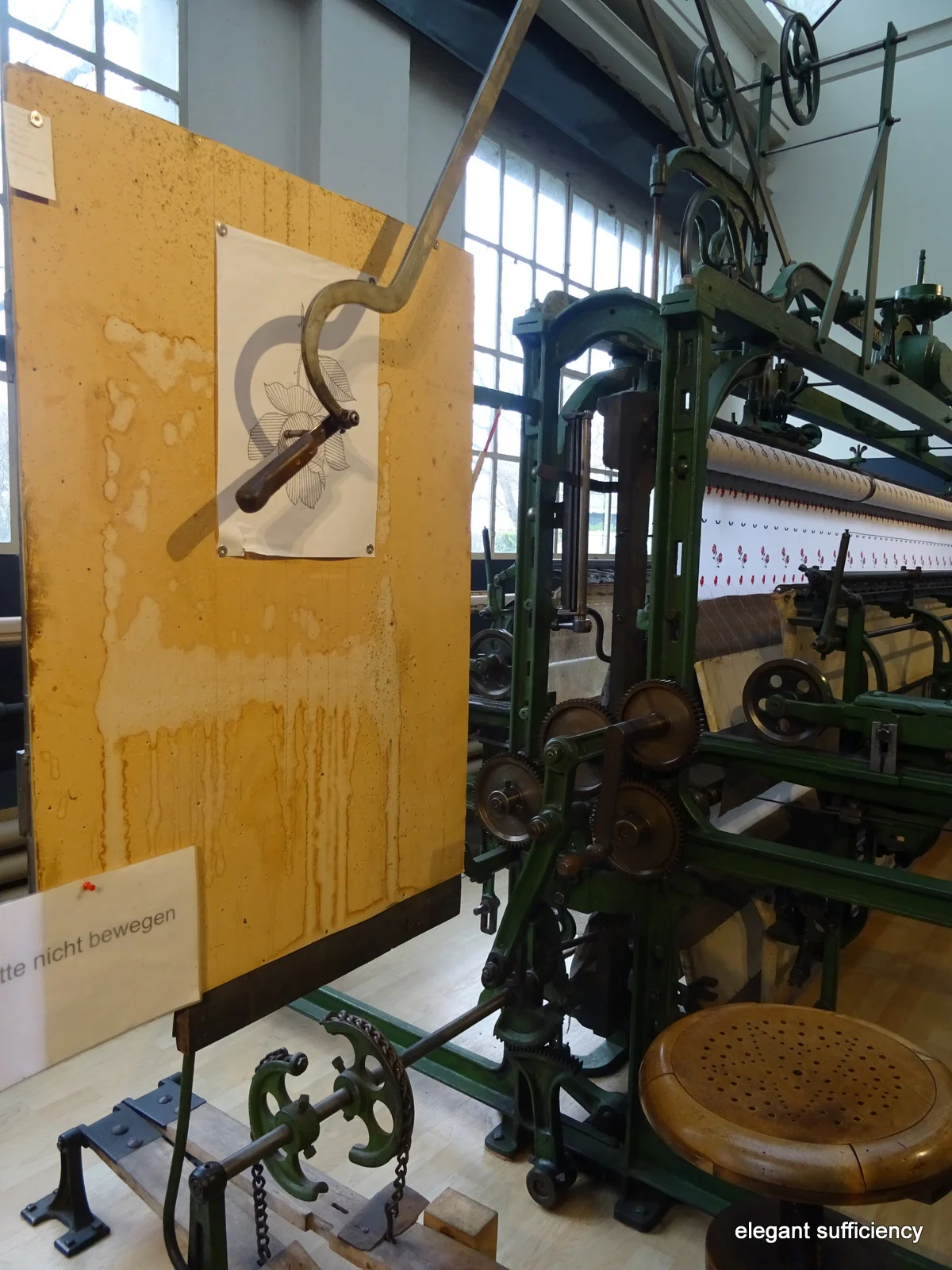Kirschblüte & Edelweiss
If ever there was a theme to tick all the boxes, then an exhibition about textiles influenced by the Swiss textile industry and Japanese design was going to be the one. I’d read about it on the Bernina blog last week and printed off the details, because it was in St Gallen and maybe, just maybe it would fit nicely with a visit to the Bernina factory? Of course, this part of Switzerland is the home of fine textiles; that Bernina is based in Steckborn is no accident and on previous visits we’ve found ourselves in assorted factory shops including Wolford a couple of years ago. The textile museum in St Gallen is home to a wonderful collection of Swiss made lace and fine fabrics as well as a comprehensive library of specialist printed books as well as samples.
We squeezed the car into a tiny spot and made our way down the street. Finding the museum entrance was rather easier than we’d anticipated!
We loved the tickets, printed on scraps of fabric and were especially pleased that the elegant lady on the reception desk carefully found us two very different designs.
The panel at the top of the stairs summed up the theme nicely, with a vignette of Fuji-san framed with edelweiss flowers!
The exhibition began with a few examples of oriental fabrics followed by a display of traditional Swiss designs. I loved the way these were presented, for although the light was dimmed the sheen on the embroideries was shown to great effect by these curved mounts.
Some of the Swiss whitework samples depicted a familiar motif: that of Wilhelm Tell and his son, in the same pose as the monument in Altdorf.
Our breaths were taken away by the display of katagami patterns in the next room. A video showed how these Japanese stencils were cut by hand and used to print textiles.
The precision was exquisite – this section would be around four inches wide and it was these patterns which inspired some of the fine Swiss embroidery and printing.
At the same time, the European fashion for flowered collars was being followed by Japanese craftsmen and as roses were appearing on textiles n the Orient, in Switzerland the chrysanthemum and camellias began to appear.
Here too, the displays were attractively presented and the story really well told, although it was becoming difficult to tell if we were looking at Swiss influenced Japanese work or vice versa. I think that was probably the whole point!
There were so many beautifully arranged collections, I took way too many photographs!
When my camera battery died, I switched to my phone! Sadly, the single light above each of the displays features in each of my photographs, however.
The last room featured contemporary textiles, mostly made in Switzerland but made for a Japanese market.
Japanese taste and fashion is so curious!
The next room held the library and though we didn’t have a great deal of time to linger here, I simply had to go in and take a closer look at this wonderful structure.
Those books on the table contain a wealth of samples- just opening one at a random page reveals such treasure!
Very temping to slip one in my bag… if only they were not so huge!
Before we left, we took a look inside the room at the end of the corridor, finding a huge machine in there. Though it looked like a loom, on closer inspection it appeared to be some kind of embroidery machine.
There, beside it was the paper design, drawn out on graph paper with a sample of the actual finished embroidery alongside. This appeared to be an early equivalent of the printout from the digitised design I recently completed using my Bernina Embroidery software, but how was this going to be used to embroider?
The answer was soon to hand, because a member of the museum staff appeared, hopped onto the stool and began to operate the machine. Painstakingly, she placed the point of the plotter on a point on the graph paper with her left hand and wound the handle of the machine with her right. As she did, a series of fifty of so needles made a single stitch in fifty or so small, individual motifs. She then wound the handle to return the needles to their original position before moving the plotter to the next point and repeating the process.
Though my photograph shows only one line of motifs, there were actually two, one above the other, so although the process was incredibly slow, a large number of motifs were embroidered at the same time. But when I spoke to the embroiderer about changing the colour of thread in each of those fifty needles, she raised an eyebrow… Bearing in mind the ease with which my machine will stitch out a design, the speed with which it will operate and the accuracy of each stitch, it’s remarkable how far we’ve come in little more than a hundred years.
The end result was mounted into greeting cards, for sale in the museum shop.
Our last photograph in the museum was a beautiful display of katagami patterns, possibly machine cut, larger than the originals and hung in the light of the windows behind them. This was a stunning museum, full of the most fascinating exhibits and we had really enjoyed our visit.
After a walk around St Gallen, thinking of Mary and our last visit here, we took the scenic route home, over the alpine pastures and waving as we passed by Appenzell.
Someone was rather proud of her enormous bell and posed beautifully by the roadside as we drove past. Love her!
This evening, we chose one of the many restaurants by the lakeside to enjoy Zürcher Geschnetzeltes with Rösti and watched as the sun went down over the lake.
We are so lucky to be here.










